Abstract
There is a huge interest worldwide related to continuously increasing the use of renewable energy sources (RES) for electricity generation. Romania, at this moment, even though it has to attain a share of 30.7% of RES from total energy consumption by 2030, does not have any major investment project of this kind in the near future. Photovoltaic (PV) is one of the most promising technologies, with decreasing prices for PV panels but with the disadvantage of large, needed surfaces. This study presents a solution to install PV panels where there is a need for electricity, in a large city, by using the surface of a reservoir. “Lacul Morii” Reservoir in Bucharest is the choice for the case study. The insolation and the possibility to install floating PV, as well as electricity generation, benefits for water quality and carbon dioxide (CO2) emissions reduction are assessed, and even the installation of charging stations for electric bikes and cars. The results are very promising, and the main conclusion is that, after its realization, the floating photovoltaic (FPV) plant on “Lacul Morii” Reservoir will be a source of clean electricity and a demonstration project on how to benefit from solar energy to produce electricity in large cities where there are reservoirs.
1. Introduction
To respond to current concerns regarding the negative impact of energy production on the environment, photovoltaic (PV) capacity installation has increased rapidly in the past decades. However, this renewable energy source (RES) still faces numerous challenges. An important burden of these generation sources is the occupation of the terrestrial surfaces. To meet this challenge, modern projects focus on implementing the concept of floating photovoltaic (FPV) power plants.
Solar power is now the cheapest source of electricity in history, the price/cost varying from 0.7 EUR/W (for ground solar systems) to 1.2 EUR/W (for floating systems), according to a 2021 report by the International Energy Agency [1]. However, there is something holding this clean energy powerhouse back, land use. Unlike fossil fuel power stations, solar farms need a lot of space to generate enough electricity to keep up with demand. Most solar farms are composed of ground-mounted panels that take up land that could be used to grow food or provide habitat for wildlife. Although electricity and water do not usually mix, a growing number of floating solar farms are being deployed worldwide. Floating solar panels on a lake or reservoir might sound like an accident waiting to happen, but recent studies have shown the technology generates more electricity compared with rooftop or ground-mounted solar installations. This is thanks to the cooling effect of the water beneath the panels, which can boost how efficiently these systems generate electricity by as much as 12.5%.
Furthermore, this kind of approach has also been proved to reduce the losses of water by evaporation, keeping the live storage for a longer period and decreasing CO2 emissions. This strong connection between photovoltaic and hydro is reflected by the fact that during this year’s hydropower conferences, the emphasis was on the realization of floating photovoltaic installations that could produce up to 40% of the world’s electricity [2].
The Emissions Gap Report from the United Nations Environment Programme has a subtitle, “The Heat Is On”, reflecting the conclusion of a deep analysis related to climate change [3]. The real commitment of different states is not always in-line with the real actions and with the real need to act related to greenhouse gases (GHG) emissions reduction.
As many things are to be done, there is a huge interest worldwide related to continuously increasing the use of RES for electricity generation, from which photovoltaic is one of the most promising technologies, with decreasing prices for PV panels but with the disadvantage of large, needed surfaces. FPV systems are a new form of RES-based power plants used on the surface of water bodies, such as lakes, irrigation canals, or tailings ponds [4]. Perhaps the most impressive demonstration of the exponentially increasing relevance of PV among RES is the proposal of using blockchain technology as an energy tracking solution and even proposing a SolarCoin under the model of Bitcoin cryptocurrency [5].
Lately, large reservoirs have drawn the attention of PV farms developers, as their free surface can offer support for PV panels with mutual benefits for the reservoirs and for PV panels. Overcoming the limits of land availability, the technology of installing PV panels on reservoirs’ surfaces, FPV, has become of huge interest in recent years and gave rise to a booming increase in implementation [6]. It is described by some authors as “an unstoppable tide” [7], forecasting 13 GW of installed capacity in new FPV plants by 2023. The deployment of existing projects at the beginning of 2019 is presented in [8], totalizing 1300 MWp installed capacity in more than 300 FPV plants, 73% of the total being in China. At the end of 2019, the global installed capacity in FPV was 2400 MWp [9]. In terms of energy generation, it is reported an increase from 1.1 to 11 MWh/year from 2009 to 2014, a jump to 68 MWh for 2015 and a doubling every year from 169 MWh in 2016 to around 1600 MWh in 2019 and an estimate of 118,000 MWh/year in 2025 [8,10]. This is the reason why World Group Bank published in 2019 produced a comprehensive FPV handbook for practitioners with all needed information to move from water surfaces to wires [11].
The interest in the industry goes hand in hand with that of the scientists. From the beginning of the installation of FPV in 2007 with a 20 kW capacity for research goals in Japan, since now many papers have addressed subjects related to FPV: water cooling effect on the power output of FPV panels, operation of the new FPV system in an agriculture reservoir consisting of polyethylene floating modules, main components of FPV systems (pontoons, floats, mooring system, PV modules, underwater cables, electrical connections, inverters, interconnection among PV modules, operation and control, evaporation reduction, water quality, etc.) [12]; cooling of FPV and the importance of water temperature [13]; technical advancements, economics and environmental issues of FPV, either hybrid or multipurpose systems [14]; culminating with benefits and critical assessment related to the role of FPV in the energy-water-food nexus [15].
When standing on the shore of a lake, one can be enchanted by the wonderful stretch of water. As this observation could not be automatically extended to water surfaces covered with FPV, the design is one of the most important components of this expansive technology [16,17].
Descriptions of applications related to FPV plants in South Korea [18], or in Turkey [19], or simulations to supply electricity to a large city in Indonesia [20] are also subjects of study.
One of the most preferred subjects related to FPV is the potential assessment, as it was presented the technical potential for anthropic reservoirs in the US [21], or in Africa [22], or it was assessed the potential of different FPV technologies [23], or the evaluation of energy generation of an existing FPV plant [24], or comparison of estimated and measured electric power of an FPV plant [25]. There were developed mathematical models for FPV potential assessment on fishponds [26].
Extensive research results related to occupied surfaces, the influence of water on FPV panels and of panels on water [27], and the cooling effect of FPV in different climate zones [28] are the subject of other recent papers.
About the integration of FPV plants with other RES technologies, can be mentioned the possibility to use it together with hydropower [29], or with heat pumps [30] or with another RES mix [31], or storage technologies [32].
Considerations related to mutual beneficial influence between FPV panels and reservoir water quality are underlined in most of the papers. Lima et al. also presented a state of the art article related to continuous monitoring of water quality parameters with sensors and underwater drones [33].
In the last ten years, Romania installed more than 1300 MW in ground-mounted PV power plants. This Romanian experience in PV systems can be completed by the real scale laboratories, for example, those existing in Romanian technical universities, related to different PV cells and panels technologies [34], eventually integrated with other RES [35] and even analysis of the operation in difficult conditions [36].
In Romania, the management of the country’s waters and the infrastructure of the National System of water management is done by National Administration “Romanian Waters” (NARW), a national public institution [37]. NARW operates based on management and economic autonomy, having 11 Water Basin Administrations, is coordinated by the Ministry of Environment, Waters, and Forests, and implements the policies and strategies of water management at the national level.
Among NARW’s main activities can be mentioned:
- -
- Sustainable management of surface and groundwater resources and their protection against depletion and degradation;
- -
- The administration, operation, and maintenance of the water minor riverbeds, of the reservoirs and ponds, in their natural or improved state, of the sea cliff and beach, of the wetlands and of the protected ones;
- -
- Elaboration of the master plans for the hydrographic basins;
- -
- The allocation of the permit to use surface and groundwater resources in all its forms of use, with their natural potentials, except for living water resources, based on subscriptions, according to the provisions of the Water Law;
- -
- Maintenance and operation of water management work with flood defense role.
As NARW has in administration more than 1600 reservoirs, it is perhaps the most entitled Romanian authority to test and to start to develop FPV systems.
Dambovita River starts its course in the Southern Carpathians and flows towards the Arges River, crossing more than 15 localities, including the capital of Romania, Bucharest. Over time, the Dambovita River has been used as a water source for the riverine/nearby localities and as a recreational place, but it has also caused major damages during flood periods. Today, it has its course regulated along Bucharest, and, in order to prevent the flooding of the city, in 1986 it was built “Lacul Morii” Reservoir (LMR) right at the entrance in the city. LMR is one of the many reservoirs administrated by NARW and, for certain, the most visible. Related to Dambovita regulated riverbed in Bucharest was already presented the idea of installing PV panels alongside [38].
This paper presents the assessment of the possibility to realize a 1 MW FPV placed on LMR to ensure NARW own electricity consumption for the dam’s equipment, buildings, and warehouses, e.g., to ensure the self-sufficiency of the local services of NARW. At the same time, given the differences between energy production and NARW consumption, the integration of a battery energy storage system is considered as well. Thus, we propose and analyze the storage of the surplus energy and its subsequent use by creating a multifunctional electricity supply station with two charging stations.
The paper is organized as follows: Section 2 briefly presents LMR in terms of characteristics, position, water quality, insolation, and the proposed FPV system type. Section 3, dedicated to results, presents the estimation of solar potential, FPV characteristics, operating scenarios, and power quality of influence on water quality and CO2 emissions reduction. A discussion of findings is presented in Section 4, and the main conclusions and proposals for future work are in Section 5.
2. Materials and Methods
The purpose of this study is to investigate the possibility of installing a floating PV power plant in the Romanian capital, Bucharest, on “Lacul Morii” reservoir (LMR), located on the Dambovita River that crosses the city (Figure 1) [39]. LMR, the largest reservoir in Bucharest, is formed by “Lacul Morii” dam, mobile type and contour dikes and is part of a complex hydrotechnical development, including the interconnection of the Argeș, the Dâmbovița, and the Ialomița rivers.
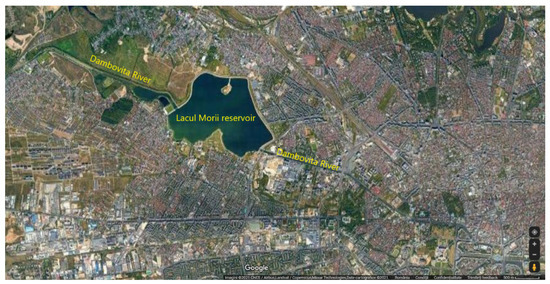
Figure 1.
View of “Lacul Morii” Reservoir (LMR) [39].
LMR covers an area of 246 ha and has other potential water uses: providing water for CET Grozavesti (District Heating Power Plant), irrigation, pisciculture, production of electricity (foreseen in the project, but the hydropower plant has not been built yet). The reservoir is formed by a 15 m high dam, has a volume of 14.7 Mm3 and a flood mitigation capacity of 1.6 Mm3. LMR is in the plain area, at an altitude of 81 masl, and belongs to the ROLA01 typology. The reservoir has an average depth of 8.5 m, dam length 409 m, a retention time of 45 days, and the nature of the bottom is siliceous. Downstream LMR, the Dambovita riverbed is channelized in a trapezoidal concrete shape for freshwater, and beneath, in a closed gallery, has collected the wastewater from the sewerage system of Bucharest (conducting it to Glina wastewater treatment plant). Its course in Bucharest is interrupted and regulated by 11 hydrotechnical nodes. In terms of water quality, both “Lacul Morii” reservoir and the Dambovita River can be classified as good status/potential surface water bodies. The water quality measurements are conducted as stipulated in the national and European legislation; thus, for the reservoir, four measurements are done every year in two sections, at the middle of the reservoir and at the dam.
Results of some measured water quality parameters from the year 2020 are presented. Figure 2 is a representation of the variation in air and water temperature in April, June, August, and October 2020, in the two sections: middle of the reservoir (MR) and at the dam (D), in °C.
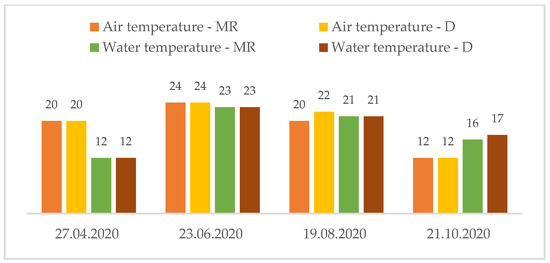
Figure 2.
Variation of temperature (air and water) in LMR, in °C. MR: middle of the reservoir; D: dam.
Figure 3 contains the representations of pH, dissolved oxygen (DO), in mg/L, and biochemical oxygen demand (BOD5), in mgO2/L, and Figure 4 the representations of total nitrogen (TN), in mgN/L, and total phosphorous (TP), in mgP/L, at the same dates of the year 2020 and the same two sections: middle of the reservoir (MR) and at the dam (D).
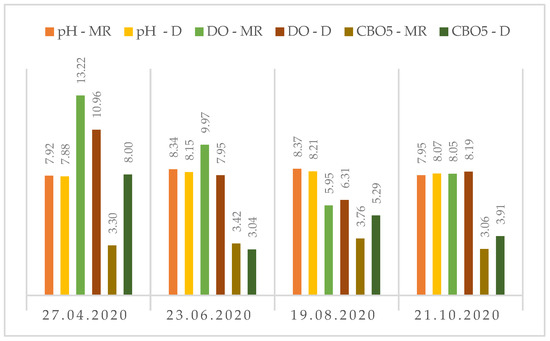
Figure 3.
Variation of pH, DO and BOD5 in LMR, in (mg/L) (MR—middle of the reservoir, D—dam).
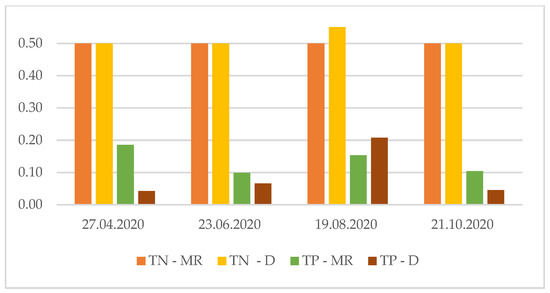
Figure 4.
Variation of TN and TP in LMR, in mg/L. MR: middle of the reservoir; D: dam.
The monthly energy consumption for the facilities and equipment of “Lacul Morii” dam is on average 2380 kWh (maximum value is 3820 kWh), while the following 11 hydrotechnical nodes have consumptions varying between 200 and 2500 kWh (NARW data).
Considering the area’s yearly sum of solar irradiation of 1480 kWh/m2, the produced electricity will supply multiple loads subordinated to NARW, such as offices, facilities, and equipment of “Lacul Morii” dam, gates at the 10 hydrotechnical nodes of the Dambovita River across Bucharest, and other facilities of Water Management System Ilfov, who administrate LMR.
In brief, the paper objective is to present the possibility of engineering, implementation, commissioning, and operation of a smart 1 MW installed capacity FPV power plant to partially cover own electricity consumption of NARW and the electricity need for an e-mobility project in Bucharest, in a way that it may be used as an easily replicable model for other Romanian local communities. The considered capacity of 1 MW for the FPV power plant leads to coverage of around 8000 m2 of the reservoir surface, meaning 0.32% of its total surface. The technical solution of battery-operated e-Mobility stations will act as a pilot for the future of mobility. The proposed hub is a multifunctional electricity fueling station with two charging stations.
To run the simulations for the power plant planning, the PVsyst software was chosen, as it requires few inputs for the project location, demanded capacity, the solar module, and inverter technologies [40]. The PVsyst software is one of the most popular solar installers currently used and represents an efficient instrument that allows the accurate analysis of various configurations of a complete PV system. Based on the comprehensive software datasets for all the solar system components, the optimal technical solution for grid-connected, stand-alone, and DC-grid PV systems can be easily achieved.
The PV modules are considered to be assembled on plastic floating pontoons oriented towards the equator. Modules have lower operational temperatures due to cooling by evaporation of surface water. A higher mismatch between modules in a string (wave-induced mismatch) and higher soiling due to bird droppings is expected. In this example, installation, string inverters, and distribution transformers were considered. In comparison to large-scale ground-mounted PV installations, the expected availability of the system is lower due to a harsher environment, with a higher probability of occurrence of various failure types.
Another method used for determining PV capacity is Global Solar Atlas 2.0 [41], a free, web-based application is developed and operated by the company Solargis s.r.o. on behalf of the World Bank Group, utilizing Solargis data, with funding provided by the Energy Sector Management Assistance Program (ESMAP), which proved to be very accurate in pinpointing the location “Lacul Morii” and provided a series of analytical parameters of the proposed FPV, considering a maximum output capacity of 1000 kW in DC.
The two assessment methods were applied for the estimation of FPV plant energy generation. Thus, Figure 5 depicts the sun path diagram corresponding to the project location (44°45′ N, 26°02′ E), which indicates the sun’s position across the sky at any point of time during the day, throughout the year determined using Global Solar Atlas. Figure 6 presents the monthly solar irradiation estimates for the 2014–2016 period determined using a free interactive tool provided by the European Commission, PVGIS [42].
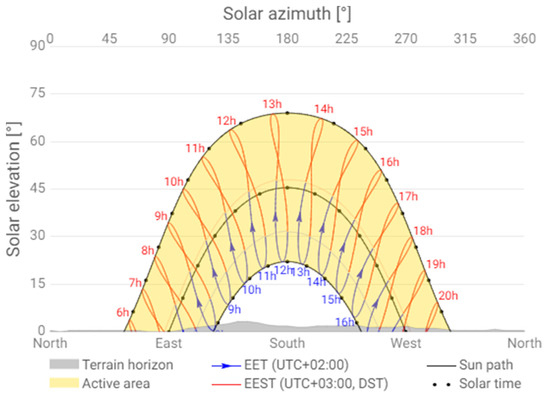
Figure 5.
Solar path for the FPV plant on LMR (Global Solar Atlas Website) [41].
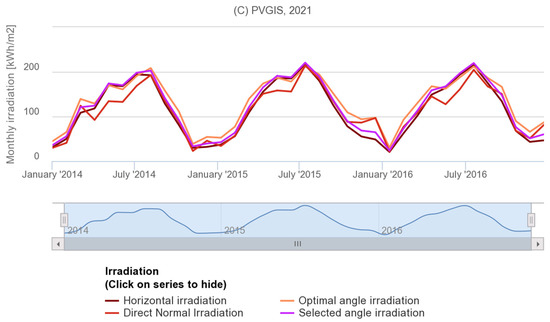
Figure 6.
Monthly solar irradiation estimates for LMR (44°45′ N, 26°02′ E) (PVGIS) [42].
A brief description of the main components of the FPV system is given below: PV modules, floating systems, and inverters. In the case of the first component, poly or monocrystalline solar panels are usually used. The common material used in most FPV projects is high-density polyethylene (HDPE), but we can also consider the use of other materials such as medium density polyethylene (MDPE), fiber-reinforced plastic (FRP), or ferro-cement. The DC power generated by the FPV must be converted to AC power by inverters that can be mounted on both floating and land platforms.
In terms of design, the two main classes of floating systems are pure floats and pontoon and metal structures. In the first case, the modular components are joined together based on screws forming a large floating platform. To allow access to maintenance or repair works, it is considered that each unit should consist of main and secondary floats. The second design consists of a metal structure like terrestrial photovoltaic units and pontoons to ensure buoyancy. This solution has a high lifetime of the connecting elements but also rigidity of the structure [43].
The anchoring system must ensure the stability of the floating structure by automatic adjustment according to the variation of the water level. There are three solutions for mooring, namely, anchoring the banks, anchoring the bottom, or anchoring the piles. Anchorage, used for small and shallow places, is a cost-effective solution but with a negative visual impact on the landscape. The most common anchoring system is the bottom anchoring, and this is due to its flexibility and wide applicability. The anchoring solution by using piles, although it allows the FPV installation to cope with variations in water level, is an expensive solution [43].
Like the land solar projects, the solar PV modules for FPV plants can utilize various technologies whose selection depends on the space, cost, relative humidity, and other external factors. The previous experience showed that a lower panel installation angle of 10° for floating PV modules leads to increased power generation compared to the typical ground-placed PV, where the applied angles vary within 30–36° range [44].
For the considered project, the PV modules were assembled on plastic floating pontoons oriented towards the equator. Modules have lower operational temperatures due to cooling by evaporation of surface water. A higher mismatch between modules in a string (wave-induced mismatch) and higher soiling due to bird droppings was expected (yearly soiling loss factor of 3%). In this example, installation, string inverters, and distribution transformers were considered. In comparison to large-scale ground-mounted PV installations, the expected availability of the system was lower due to a harsher environment, with a higher probability of occurrence of various failure types.
3. Results
3.1. Estimation of Solar Potential and of FPV Characteristics
The considered FPV systems contains 105 strings of 27 panels in landscape position to increase the stability of the floating platforms, while the pitch distance between two-panel rows is 5.5 m, to reduce losses caused by shading. Six inverters will convert the produced energy to the electrical network parameter, while a lithium-ion storage system will ensure the local load supply during off-production hours. The design parameters of the (Solar cell modules) photovoltaic panels are listed in Table 1.

Table 1.
Design parameters for the photovoltaic panels considered in the study.
The generation predictions provided by the two methods (PVsyst and Global Solar Atlas) were very similar and illustrated below.
The total electricity production of the 1 MW installed capacity FPV plant for an average day on each month, based on the PVsyst simulation results, considering the location features, is presented in Figure 7 and is: 1185, 2014, 3018, 3788, 4406, 4764, 4822, 4424, 3405, 2373, 1380, and 962, in kWh/day, resulting in the following:
36,540 kWh × 30.5 days/month = 1114 MWh/year.
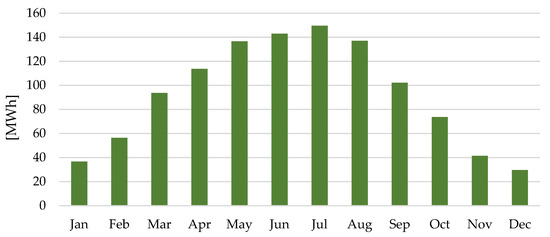
Figure 7.
Monthly averages of the total photovoltaic energy output.
The obtained value is in very good agreement with indices from the literature stating that the electricity generation from PV plants is between 600 and 1500 kWh/kWp/year [45].
As depicted in Table 2, the maximum monthly generated quantity was recorded in July (4822 kWh), while the minimum was obtained during December (962 kWh).

Table 2.
Average hourly profiles for the total photovoltaic energy output in kWh.
The power supply was ensured by a transformer station equipped with two power transformers, with a rated power of 400 kVA, voltages 10/0.4 kV, two transformer cells, and four-line cells. The technical layout of the proposed electrical scheme is presented in Figure 8, and it was composed of three main parts, namely the actual composition of the electrical network on the left side, the FPV on the right, and the new e-Mobility hub, placed on the right, at the lower part of the image.
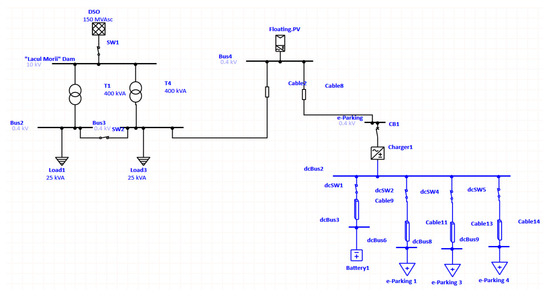
Figure 8.
Structure of the proposed electrical scheme with FPV, battery storage, and e-Parking.
3.2. Estimation of Operating Scenarios and of Power Quality Characteristics
FPV system on LMR will be able to offer charging for electric vehicles, being placed in a location where the local power grid does not meet the technical or commercial requirement for charging electric vehicles. One of the most sensitive issues in distributed generation integration into electric power networks is the subsequent downgrade in power quality.
This is due to both strong reliance upon sunlight and power electronics embedded in DC/AC and AC/DC converters which are placed at both PV and battery energy storage system (BESS) interface with the electrical network.
In order to accurately predict the system, a model was built using Electrical Transient and Analysis Program (ETAP 11) software [46] (see Figure 8), and simulations were run (see Figure 9) against every scenario in order to create an accurate image for system engineers who will integrate the solution.
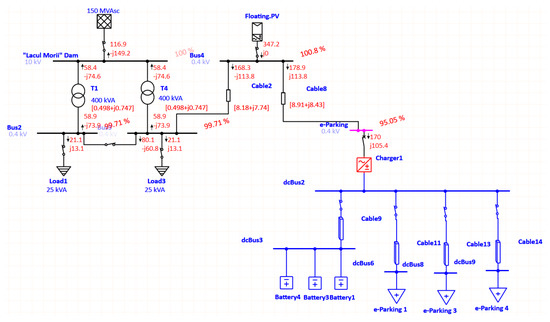
Figure 9.
Load flow calculation for a working scenario of FPV, battery storage, and e-Parking.
Another issue to be assessed also is the voltage variation or drop. A correlated issue is the energy efficiency analysis of the solution, and therefore the active power losses following different operating scenarios were computed. Thus, we have considered several scenarios for e-Parking, Local load, and PV plant operating status (ON or OFF). The simulation results for voltage drop and active power losses are presented in Figure 10 and Figure 11. The best scenarios for voltage drop were obtained for the cases in which the e-Parking and PV plant are operating, irrespective of the load operation. This conclusion is also valid for the efficiency assessment. The 1000 kW location will not be connected to the medium-voltage grid, but power is provided by a local battery, which charges when no electric vehicles are connected. This is the first stage of a microgrid; the goal is for the site to be self-sufficient with on-site electricity generation.
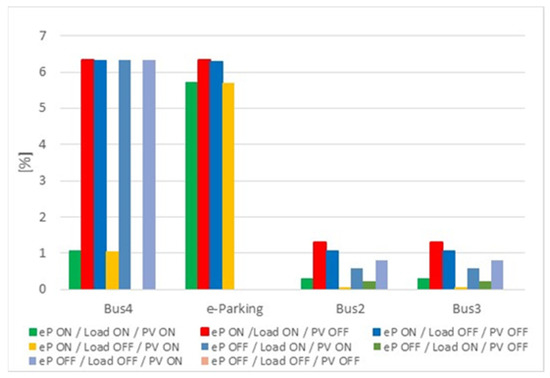
Figure 10.
Results of voltage drop analysis for the considered scenarios.
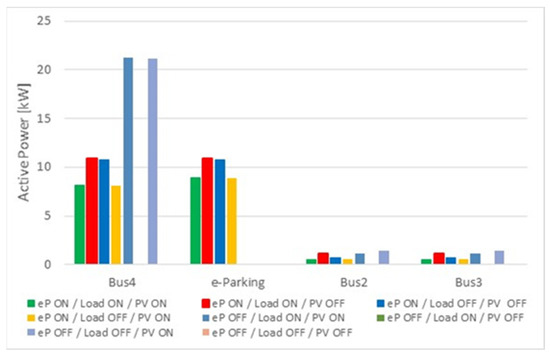
Figure 11.
Results of active power losses for the considered scenarios.
3.3. Estimation of the Influence of FPV on Water Quality and of CO2 Emissions Reductions
The influence of FPV on water quality is still a research subject that has not been thoroughly investigated. The scientific literature does not contain too many studies in this area since it is one of the newest challenges of the energy sector.
Quality monitoring of “Lacul Morii” reservoir is done according to the national and European standards. The quality indicators measured consist of biological (phytoplankton, aquatic flora, benthic invertebrates, and fish), hydro-morphological and physicochemical parameters. As it can be seen in the figures presented in the Materials and Methods (Figure 2, Figure 3 and Figure 4), LMR does not have any problems in terms of water quality. Thus, and given the fact that only a small surface of the reservoir will be occupied by FPV (0.32%), there are no expected important changes, except the lowering of the evaporation, which can be translated into a small gain in water volume.
The estimation of CO2 emissions reductions is one the most important factor when speaking about replacing electricity generation from conventional sources with electricity produced from RES.
The electricity generation of the 1 MW installed capacity FPV plant is estimated to be 1114 MWh/year (1). This quantity of energy used by NARW replaces that from the national power system (NPS). For each 1 MWh Romania mix, at the level of the year 2016, the conversion factor was estimated at 306 kgCO2eq/MWh [47]. Considering that PV panels produce electricity with zero GHG emissions [48], the greenhouse gas emissions reduction can be determined with the following formula:
GHG emissions reduction = 1114 × 306 = 341 tCO2eq/year.
4. Discussion
In this study, the potential of FPV in supplying urban power loads was investigated. Similar findings are reported for reservoirs in southern Europe [49]. Thus, Baptista et al. studied a FPV system to be placed on Gouvães reservoir, with a capacity of 1 MW, obtained by using 2941 panels of 340 W each, comparing to our proposal to use 2835 panels of 410 W each, for the same installed capacity. The total annual energy production reported by Baptista et al. is 1.8 GWh, comparing to LMR’s 1.14 GWh. The reason is that there are major differences between monthly solar irradiation values, which further translate into FPV’s monthly average power outputs, as follows:
- -
- For Gouvães reservoir, monthly solar irradiation varies from 50 to 250 kWh/m2, while for LMR, the range is 20 to 200 kWh/m2;
- -
- For Gouvães reservoir FPV’s monthly energy generation vary from 80 to 210 MWh/month, while for LMR, the range is 30 to 150 MWh/month.
Related to the case study, “Lacul Morii” reservoir, it was underlined its significance from the point of view of the location, in Bucharest, a city with around four million inhabitants and with a large need of electricity. Only around 0.32% from the reservoir surface will be covered by a proposed FPV power plant built by NARW, which will cover most of the electricity consumption, replacing that from the national power grid.
There were presented issues related to water quality for the year 2020 during the four yearly measurement campaigns (in April, June, August, and October) performed by NARW in two sections: middle of the reservoir (MR) and at the dam (D). The measurement parameters were: the temperature of air and water, pH, DO, BOD5, TN, and TP. The results demonstrate that LMR does not have any problems in terms of water quality.
Then, for the 1 MW installed capacity FPV power plant, there were used PVsyst and Global Solar Atlas methods for the evaluation of the plant energy generation. Both methods provided similar results, namely 1114 MWh/year.
A brief description of the main components of the FPV system was done, and estimation of operating scenarios and of power quality characteristics is presented.
The simulations showed that the integration of this solution would require careful coordination between the dam operator and the distributed system operator to ensure both lower impact on voltage, as well as reduced active power losses for the cases in which e-Parking is not operating and/or FPV plant is not producing energy. Under these circumstances, plot modifications are required at transforming substations to maintain the voltage within limits. A deeper investigation is required to assess the harmonic distortion levels produced by loads, e-Parking charger, and FPV plant inverter, for dangerous current levels which may impede the correct operation of loads, as well as their emission upstream on the 10 kV system.
Related to the influence of FPV power plants on water quality, it is expected to be negligible to only 0.32% of the reservoir surface covered. Moreover, the influence of the water on FPV power plant energy generation is beneficial, as underlined in the Introduction section, so we envisaged even more energy generation than the 1114 MWh/year prognosis. With the installation of the FPV plant, more measuring scenarios will be envisaged for determining the influence of water on PV panels operation, on the one hand, and of the FPV panels on water parameters and quality, on the other hand.
From an economic point of view, considering an investment value of around 1 EUR/kWh results in a return of around 1.2 MEUR. Considering that the FPV electricity generation of 1114 MWh/year will be used by NARW for electricity consumption, it will replace electricity that is now purchased from the national power grid with around 110 EUR/MWh. It results in earnings of about 122,540 EUR/year that can be considered when realizing the FPV power plant. The operational costs of such an FPV power plant are around 5000 EUR/year. With these figures and without considering any support scheme (in Romania, the support scheme was mandatory quotas combined with tradable green certificates until 31 December 2016 when the national targets were attained), the cash flow shows that the cost is recovered in 10 years. It must be mentioned the fact that at this moment the price for the electricity is increasing and that new support scheme is envisaged to be launched.
5. Conclusions
This study investigates the possibility of placing an FVP on the LMR in Bucharest, Romania. The results show that it is possible to develop a 1 MW FPV plant on LMR, which will cover just 0.32% from the reservoir’s surface, and with no harmful effects on the aquatic ecosystem. The FPV power plant will produce 1114 MWh/year, and an annual CO2 emission reduction of 341 tCO2 eq/year is estimated.
If this project is realized, numerous benefits will result from it, as follows:
- Increasing of installed capacity and in energy generation from RES in Romania;
- Realization of the first FPV in Romania;
- Fully cover the electricity consumption of NARW facilities in Bucharest from RES and the surplus to be supplied into the national power grid (NPG) to be compensated with a part of electricity consumption of other NARW assets and facilities;
- Increase population awareness related to RES, namely FPV, as the power plant is situated on an iconic reservoir for Bucharest, thus for Romania (it can be provided an observation point with information related to RES in general and the existing FPV plant on “Lacul Morii” reservoir).
The innovation of the approach presented in this study consists of multiple layers. The first one regards the use of this state-of-the-art technology in a European Capital, which will also represent the first application of this type in Romania. The second is the common use of an FPV and e-Parking system for the purpose of lowering the city’s carbon footprint and creating a smart hub and seamlessly integrating it into Bucharest’s push for achieving carbon neutrality. Another layer is the fact that with this system, NARW will realize the first smart hub powered by FPV in Romania, which will promote it as an operating concept, able to be replicated at various scales within Romania, for the same purpose of lowering the carbon footprint and helping Romania achieving carbon neutrality until 2050.
The results are very promising, and the main conclusion is that, after its realization, the FPV plant on the “Lacul Morii” Reservoir will be a source of clean electricity and a demonstration project on how to benefit from solar energy to produce electricity in large cities where there are reservoirs. Moreover, from the point of view of significance and location, besides the fact that LMR is in the most appropriate position to become a symbol for the sustainability of the Romanian capital, the FPV power plant is perfect for improving the University Politehnica of Bucharest (UPB) student’s knowledge and skills related to RES integration, namely FPV, UPB being at a walking distance from LMR.
Author Contributions
Conceptualization, B.P., L.I.V., G.E.D. and R.-F.P.; Formal analysis, B.P., L.I.V., I.P. and M.C.-A.; Investigation, G.E.D.; Methodology, B.P., L.I.V., G.E.D., M.C.-A. and R.-F.P.; Resources, B.P. and L.I.V.; Software, I.P., M.C.-A. and R.-F.P.; Validation, I.P. and R.-F.P.; Visualization, I.P., M.C.-A. and R.-F.P.; Writing—original draft, B.P. and G.E.D.; Writing—review and editing, B.P., L.I.V. and R.-F.P. All authors have read and agreed to the published version of the manuscript.
Funding
The APC was funded by the University POLITEHNICA of Bucharest.
Institutional Review Board Statement
Not applicable.
Informed Consent Statement
Not applicable.
Data Availability Statement
Data are available on request and will be provided only with the consent of NARW.
Acknowledgments
The authors express their gratitude to NARW for providing the necessary data and supporting this study.
Conflicts of Interest
The authors declare no conflict of interest.
References
- IEA. Global Energy Review 2021; IEA: Paris, France, 2021; Available online: https://www.iea.org/reports/global-energy-review-2021 (accessed on 13 November 2021).
- AquaMedia International with ICOLD’s Technical Committee on Emerging Challenges & Solutions, Solar Hydro 2021. Available online: https://www.hydropower-dams.com/solar-hydro (accessed on 13 November 2021).
- United Nations Environment Programme. Emissions Gap Report 2021: The Heat Is on—A World of Climate Promises Not Yet Delivered; UNEP DTU: Nairobi, Kenya, 2021. [Google Scholar]
- Bertsch, V.; Geldermann, J.; Lühn, T. What drives the profitability of household PV investments, self-consumum and self-suficiency? Appl. Energy 2017, 204, 1–15. [Google Scholar] [CrossRef] [Green Version]
- Enescu, F.M.; Bizon, N.; Onu, A.; Raboaca, M.S.; Thounthong, P.; Mazare, A.G.; Serban, G. Implementing Blockchain Technology in Irrigation Systems That Integrate Photovoltaic Energy Generation Systems. Sustainability 2020, 12, 1540. [Google Scholar] [CrossRef] [Green Version]
- Cazzaniga, R.; Rosa-Clot, M. The booming of floating PV. Solar Energy 2021, 219, 3–10. [Google Scholar] [CrossRef]
- Beetz, B. PV Magazine: 14 PV Trends for 2019. Available online: https://www.pv-magazine.com/2018/12/31/14-pv-trends-for-2019/ (accessed on 13 November 2021).
- World Bank Group; Energy Sector Management Assistance Program; Solar Energy Research Institute of Singapore. Where Sun Meets Water: Floating Solar Market Report; World Bank: Washington, DC, USA, 2019; Available online: https://openknowledge.worldbank.org/handle/10986/31880 (accessed on 14 September 2021).
- Cox, M. Floating Solar Landscape. 2019. Available online: https://www.greentechmedia.com/articles/read/the-state-of-floating-solar-bigger-projects-and-climbing-capacity (accessed on 7 July 2021).
- Acharya, M.; Devraj, S. Floating Solar Photovoltaic (FSPV): A Third Pillar to Solar PV Sector ? In TERI Discussion 2019; The Energy and Resources Institute (TERI): New Dehli, India, 2019. [Google Scholar]
- Energy Sector Management Assistance Program; Solar Energy Research Institute of Singapore. Where Sun Meets Water: Floating Solar Handbook for Practitioners; World Bank: Washington, DC, USA, 2019; Available online: https://openknowledge.worldbank.org/handle/10986/32804 (accessed on 14 September 2021).
- Ranjbaran, P.; Yousefi, H.; Gharehpetian, G.B.; Astaraei, F.R. A review on floating photo-voltaic (FPV) power generation units. Renew. Sustain. Energy Rev. 2019, 110, 332–347. [Google Scholar] [CrossRef]
- Kjeldstad, T.; Lindholm, D.; Marstein, E.; Selj, J. Cooling of floating photovoltaics and the importance of water temperature. Sol. Energy 2021, 218, 544–551. [Google Scholar] [CrossRef]
- Gorjian, S.; Sharon, H.; Ebadi, H.; Kant, K.; Scavo, F.B.; Tina, G.M. Recent technical advancements, economics and environmental impacts of floating photovoltaic solar energy conversion system. J. Clean. Prod. 2021, 278, 124285. [Google Scholar] [CrossRef]
- Gadzanku, S.; Mirletz, H.; Lee, N.; Daw, J.; Warren, A. Benefits and Critical Knowledge Gaps in Determining the Role of Floating Photovoltaics in the Energy-Water-Food Nexus. Sustainability 2021, 13, 4317. [Google Scholar] [CrossRef]
- Solomin, E.; Sirotkin, E.; Cuce, E.; Shanmuga Priya, S.; Kumarasamy, S. Hybrid Floating Solar Plant Designs: A Review. Energies 2021, 14, 2751. [Google Scholar] [CrossRef]
- Abid, M.; Abid, Z.; Sagin, J.; Murtaza, R.; Sarbassov, D.; Shabbir, M. Prospects of floating photovoltaic technology and its implementation in Central and South Asian Countries. Int. J. Environ. Sci. Technol. 2018, 16, 1755–1762. [Google Scholar] [CrossRef]
- Sun-Hee, K.; Soon-Jong, Y.; Wonchang, C.; Ki-Bong, C. Application of Floating Photovoltaic EnergyGeneration Systems in South Korea. Sustainability 2016, 8, 1333. [Google Scholar] [CrossRef] [Green Version]
- Kaymak, M.K.; Şahin, A.D. The First Design and Application of Floating Photovoltaic (FPV) Energy Generation Systems in Turkey with Structural and Electrical Performance. Int. J. Precis. Eng. Manuf. -Green Technol. 2021, 1–13. [Google Scholar] [CrossRef]
- Tarigan, E. Simulation of the Floating PV System to Supply Electricity Demand for the City of Surabaya, Indonesia. In Proceedings of the 6th International Conference on Renewable Energy: Generation and Applications (ICREGA), Al Ain, United Arab Emirates, 2–4 February 2021; pp. 48–53. [Google Scholar] [CrossRef]
- Spencer, R.S.; Macknick, J.; Aznar, A.; Warren, A.; Reese, M.O. Floating Photovoltaic Systems: Assessing the Technical Potential of Photovoltaic Systems on Man-Made Water Bodies in the Continental United States. Environ. Sci. Technol. 2019, 53, 1680–1689. [Google Scholar] [CrossRef]
- Sanchez, R.G.; Kougias, I.; Moner-Girona, M.; Fahl, F.; Jäger-Waldau, A. Assessment of floating solar photovoltaics potential in existing hydropower reservoirs in Africa. Renew. Energy 2021, 169, 687–699. [Google Scholar] [CrossRef]
- Oliveira-Pinto, S.; Stokkermans, J. Assessment of the potential of different floating solar technologies—Overview and analysis of different case studies. Energy Convers. Manag. 2020, 211, 112747. [Google Scholar] [CrossRef]
- Choi, J.Y.; Hwang, S.T.; Kim, S.H. Evaluation of a 3.5-MW Floating Photovoltaic Power Generation System on a Thermal Power Plant Ash Pond. Sustainability 2020, 12, 2298. [Google Scholar] [CrossRef] [Green Version]
- Suh, J.; Jang, Y.; Choi, Y. Comparison of Electric Power Output Observed and Estimated from Floating Photovoltaic Systems: A Case Study on the Hapcheon Dam, Korea. Sustainability 2020, 12, 276. [Google Scholar] [CrossRef] [Green Version]
- Château, P.A.; Wunderlich, R.F.; Wang, T.W.; Lai, H.T.; Chen, C.C.; Chang, F.J. Mathematical modeling suggests high potential for the deployment of floating photovoltaic on fish ponds. Sci. Total Environ. 2019, 687, 654–666. [Google Scholar] [CrossRef]
- Cagle, A.E.; Armstrong, A.; Exley, G.; Grodsky, S.M.; Macknick, J.; Sherwin, J.; Hernandez, R.R. The Land Sparing, Water Surface Use Eciency, and Water Surface Transformation of Floating Photovoltaic Solar Energy Installations. Sustainability 2020, 12, 8154. [Google Scholar] [CrossRef]
- Dörenkämper, M.; Wahed, A.; Kumar, A.; de Jong, M.; Kroon, J.; Reindl, T. The cooling effect of floating PV in two different climate zones: A comparison of field test data from The Netherlands and Singapore. Sol. Energy 2021, 219, 15–23. [Google Scholar] [CrossRef]
- Cazzaniga, R.; Rosa-Clot, M.; Rosa-Clot, P.; Tina, G.M. Integration of PV floating with hydroelectric power plants. Heliyon 2019, 5, e01918. [Google Scholar] [CrossRef] [Green Version]
- Bellini, E. European Consortium Develops Ways to Couple Heat Pumps with Solar Panels. 2021. Available online: https://www.pv-magazine.com/2021/11/11/European-consortium-develops-ways-to-couple-heat-pumps-with-solar-panels/ (accessed on 13 November 2021).
- Choi, J.Y.; Oh, B.C.; Acquah, M.A.; Kim, D.M.; Kim, S.Y. Optimal Operation of a Hybrid Power System as an Island Microgrid in South-Korea. Sustainability 2021, 13, 5022. [Google Scholar] [CrossRef]
- Cazzaniga, R.; Cicua, M.; Rosa-Clota, M.; Rosa-Clota, P.; Tinab, G.M.; Venturab, C. Compressed air energy storage integrated with floating photovoltaic plant. J. Energy Storage 2017, 13, 48–57. [Google Scholar] [CrossRef]
- de Lima, R.L.P.; Paxinou, K.; Boogaard, F.C.; Akkerman, O.; Lin, F.Y. In-SituWater Quality Observations under a Large-Scale Floating Solar Farm Using Sensors and Underwater Drones. Sustainability 2021, 13, 6421. [Google Scholar] [CrossRef]
- Nedelcu, O.; Salisteanu, I.C.; Ivanovici, T.; Dogaru, V.; Energy passivation of a building. The ICSTM building case study. E3S Web Conf. 2019, 112, 02003. [Google Scholar] [CrossRef]
- Popa, B.; Nedelcu, O.; Popa, F.; Ahmad-Rashid, K.; Tica, E.-I. Small Hydropower Plant for Sustainable Electricity from RES Mix. Sustainability 2021, 13, 2402. [Google Scholar] [CrossRef]
- Husu, A.G.; Stan, M.F.; Cobianu, C.; Fidel, N.; Nedelcu, O. An Inedited Solution to Increase the Energy Efficiency of Photovoltaic Panels for Regions with Snow. In Proceedings of the 13th International Conference on Engineering of Modern Electric Systems (EMES), Oradea, Romania, 11–12 June 2015; pp. 1–4. [Google Scholar] [CrossRef]
- National Administration “Romanian Waters” (NARW) Website. Available online: https://rowater.ro/ (accessed on 13 November 2021).
- Ciocanea, A.; Dragomirescu, A.; Tofan, B.; Toti, M. Pedestrian-level ventilation in an urban environment adjacent to a river channel: A case study for Bucharest city—Romania. E3S Web Conf. 2019, 85, 07007. [Google Scholar] [CrossRef] [Green Version]
- Google Maps. Available online: https://www.google.com/maps (accessed on 13 November 2021).
- PVSyst Website. Available online: https://www.pvsyst.com (accessed on 13 November 2021).
- Global Solar Atlas Website. Available online: https://globalsolaratlas.info/map (accessed on 13 November 2021).
- European Comission, PVGIS Website. Available online: https://re.jrc.ec.europa.eu/pvg_tools/en/#PVP (accessed on 13 November 2021).
- Floating Solar Panels Website. Available online: www.floatingsolarpanels.co.uk (accessed on 13 November 2021).
- Oh, J.; Jang, J. A study on the installation angle of the marine solar power generation system. J. Navig. Port Res. 2018, 42, 167–176. [Google Scholar] [CrossRef]
- Ravichandran, N.; Ravichandran, N.; Panneerselvam, B. Performance analysis of a floating photovoltaic covering system in an Indian reservoir. Clean Energy 2021, 5, 208–228. [Google Scholar] [CrossRef]
- ETAP Website. Available online: https://etap.com/ (accessed on 13 November 2021).
- Conversion Guidelines. Greenhouse Gas Emissions. Available online: https://www.innovasjonnorge.no/globalassets/0-ryddemappe--arkiv/eea-grants/joint-application-documents/er_6-conversion-guidelines-ghg.pdf (accessed on 13 November 2021).
- Fukushima, Y.; Kuo, Y.M. Evaluation of GHG emission reduction potentials of PV system considering power mix shifts. J. Energy Eng. 2008, 134, 58–62. [Google Scholar] [CrossRef]
- Baptista, J.; Vargas, P.; Ferreira, J.R. A techno-economic analysis of floating photovoltaic systems, for southern European countries. Renew. Energy Power Qual. J. 2021, 19, 57–62. [Google Scholar] [CrossRef]
Publisher’s Note: MDPI stays neutral with regard to jurisdictional claims in published maps and institutional affiliations. |
© 2021 by the authors. Licensee MDPI, Basel, Switzerland. This article is an open access article distributed under the terms and conditions of the Creative Commons Attribution (CC BY) license (https://creativecommons.org/licenses/by/4.0/).